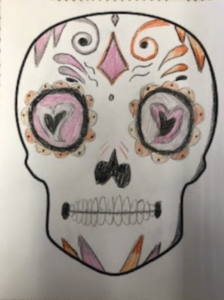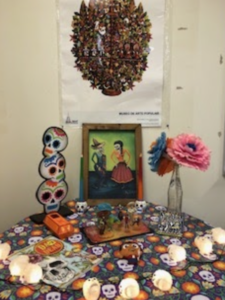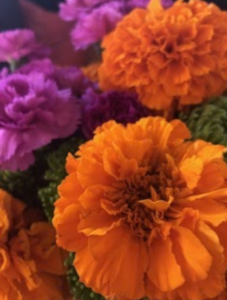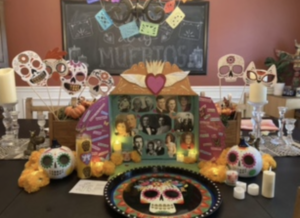October 31, 2022 by Olivia Clemmensen ’26
Although Halloween is viewed as the center of late October into November, Día de Los Muertos is another important holiday! Celebrated from November 1st through 2nd, it is a day to remember the loved ones that we have lost.

Día de Los Muertos originated from Aztec traditions. The Aztecs thought that even though the body would die, the soul would live on, and the spirit would be freed to a spiritual paradise. Within their polytheistic belief system, the Aztecs worshiped a god of the dead, Mictlantecuhtli, and his wife, Mictectecacíhuatl. Death was a happy event in their eyes and because of this, they celebrated death in the summer as a festival including symbols like skulls (“calaveras” in Spanish) and skeletons. Their festivals date back over 3,000 years. With the emergence of modern-day Mexico, this celebration moved to November and is now called Día de Los Muertos.
Known in English as the “Day of the Dead”, Día de Los Muertos is a “time set aside to remember loved ones who have passed. It’s a time to honor those through the sharing of memories, photos, and all of their favorite things,” explains Señora Ford, a Spanish teacher at Saratoga Springs High School (SSHS). Another SSHS Spanish teacher, Señora Sniezyk, explains that the Day of the Dead is a “wonderful celebration focused on the celebration of the lives of people who have died that we love.”

It is celebrated throughout Mexico and in Mexican American communities with festivities including spirited parades, parties, gorgeous art, and people singing and dancing to the traditional Mexican folk music known as Mariachi. For Día de Los Muertos in Mexico City, a popular parade is held with towering floats adorned with Day of the Dead decorations, and live music is played for the whole city to enjoy.
It is a special time of year when the souls of loved ones who have passed away are believed to come back and visit their live families to reunite again. Families gather to share funny stories about their dead loved ones with each other to keep them alive in memory. Along with sharing stories, families clean and decorate the graves of their deceased friends and relatives, decorate their homes and streets with colorful Papel Picado banners (punched paper banners with intricate designs), and set up special “ofrendas” or “altars” to welcome spirits home.

Ofrendas are very important to the Día de Los Muertos celebrations. Señor Colella, an SSHS Spanish teacher, states that “one of the main symbols of the holiday is the “ofrendas” (offerings). These are typically altars that are designated to passed family and friends. Each altar represents their life and is decorated with a picture of them as well as some of their favorite items.” They can be found in many homes and cemeteries, serving as an entryway and enabling spirits and living loved ones to reunite. They are often decorated with beautiful colors, the person’s favorite foods, drinks, photos, and sugary candles and scented marigold flowers whose aroma is supposed to help the spirit find their way home. Colella adds “In college, I used to celebrate day of the dead with other Spanish majors by creating ofrendas around our school campus, Unfortunately, I have not continued this tradition recently but would love to start it up again!”

Día de Los Muertos began in Mexico, but there are similar celebrations in other places around the world too, and other people not of Mexican heritage can respectfully participate in this joyous tradition. Many people living in the United States celebrate their own kind of Day of the Dead. Even if your family isn’t from Mexico, you can still be inspired by this holiday and remember your loved ones who have passed away.
Ford states that “one of the best things about the Spanish language is it’s spoken so widely throughout the U.S., we get to bring this special holiday and practices into our society too!” Personally, in my family, although we are not Mexican, we are inspired by Día de Los Muertos and take time to remember and honor our deceased loved ones. On November 1st, we put up our own homemade “ofrenda” featuring all our family members who have passed away.
We have a lot of fun decorating and learning about the history of Día de Los Muertos together. My mom has enjoyed our tradition, saying, “For me, it’s been a really beautiful way to honor our family and also remember those that have passed in a joyful way. It’s given us an opportunity to celebrate life and share our history with each other.” At dinner, my mom and dad share stories about our ancestors and family to my sister and me. I have learned so much about my family and what they went through, who they were, and all the love that connects all of us together. Ford relates, saying, “I think it’s so special to set aside a specific time of the year to remember our closest friends and family.”
Many of the Spanish teachers here at SSHS don’t celebrate Día de Los Muertos at home but enjoy educating their students on the celebration of the Day of the Dead at school. “A large part of learning Spanish (or any language) is understanding the culture where the language is spoken,” Ford says. She celebrates Día de Los Muertos with her class by having “discussions around the topic of how to honor those special to us who have passed.”
Colella says that to celebrate in his class, they watch “cultural videos, modern movies such as Coco, and [do] discussion activities about the many items and symbols surrounding the day of the dead.”
Día de Los Muertos isn’t just a day to mourn or to be downhearted about missing family, it’s also about remembering them and celebrating the time you had together. It is a way to look at death that is positive, full of love and remembrance. It’s a holiday that brings up many feelings. As Señora McQuade described, it is “happiness and sadness, celebration and mourning, beautiful and difficult.” So, for the start of November, spend some time with your family to remember those you have lost, and keep their memories alive. As Señora Ford said, the Day of the Dead “truly is a time of celebration.”
